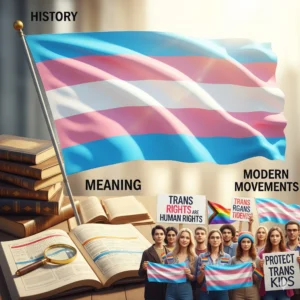Introduction: Why the Trans Flag Matters
In recent decades, the trans flag has become one of the most recognized symbols of identity, resilience, and pride for transgender communities worldwide. Much like the rainbow flag, the trans flag carries deep meaning that extends beyond colors—it represents visibility, inclusivity, and the ongoing struggle for equality. For anyone learning about LGBTQ+ history, understanding the origins and symbolism of this flag is essential.
At RankRise1, we believe in creating meaningful, authoritative content that not only educates but also supports online visibility for socially significant topics. The trans flag, as both a cultural and political emblem, continues to play a major role in conversations about rights, representation, and recognition.
The Origins of the Trans Flag
The transgender pride flag was created in 1999 by Monica Helms, a transgender activist and U.S. Navy veteran. Helms designed the flag with intentional symbolism:
-
Light Blue – Represents the traditional color for baby boys.
-
Light Pink – Represents the traditional color for baby girls.
-
White – Stands for those who are transitioning, intersex, or consider themselves outside the gender binary.
One of the most remarkable aspects of the design is its symmetry. No matter which way you fly the flag, it always looks the same, symbolizing finding “correctness” in life and the stability of being one’s true self.
Symbolism and Representation
The trans flag is more than a banner; it is a statement of existence and pride. It challenges societal invisibility, affirming that transgender individuals deserve recognition and respect. Its use at pride parades, rallies, and cultural events signals solidarity not just among trans people but across the broader LGBTQ+ spectrum.
As trans rights gain visibility worldwide, the flag is often flown in public institutions, universities, and governmental spaces—sometimes sparking heated debates that further emphasize its political and cultural weight.
The Trans Flag in Activism and Politics
The trans flag has been at the forefront of activism, serving as a unifying emblem in protests and policy campaigns. For example, in 2021, the flag was raised outside the U.S. Department of Health and Human Services, marking a historic moment of federal recognition.
However, the flag’s presence has also been politicized. News outlets such as Common Dreams have documented how the trans flag is sometimes used in protest actions to highlight discriminatory policies or public debates around transgender rights. You can read more about such political moments here:
👉 Trump Transgender Flag Story – CommonDreams
This demonstrates how a piece of cloth, through symbolism, can become a focal point for both hope and controversy in society.
Cultural Impact and Global Adoption
Today, the trans flag has transcended borders, appearing in marches from New York to London, from São Paulo to Manila. Many local LGBTQ+ groups have integrated the trans flag into their branding, campaigns, and outreach programs.
Even within online communities, emojis, digital stickers, and virtual banners of the trans flag circulate widely across platforms like Twitter, TikTok, and Instagram, allowing individuals to express their identity digitally as well as physically.
Challenges and Misuse
While the trans flag is widely celebrated, it has also been subject to challenges. Critics sometimes accuse institutions of “performative allyship”, displaying the flag during Pride Month while failing to support trans communities year-round. Additionally, in some countries, flying the trans flag has led to political backlash, censorship, or even criminal charges, underscoring the risks activists face globally.
Why Symbols Like the Trans Flag Matter
Symbols have always played a vital role in human history. The trans flag serves as a visual shorthand for identity, resistance, and solidarity. For younger generations, seeing the trans flag displayed openly is a message of acceptance. For activists, it remains a rallying call. For societies, it is a reminder of the unfinished work toward equality.
At RankRise1, we highlight how cultural symbols like the trans flag can also influence digital spaces. The more people search, read, and share content around such symbols, the more visibility the cause receives online. This is not only social advocacy but also an example of how SEO-driven content amplifies movements.
Conclusion: A Flag of Pride and Progress
The trans flag is more than a symbol; it is a declaration of existence and pride for millions of people. Its pastel stripes carry stories of resilience, its presence in public spaces fuels progress, and its recognition worldwide is a testament to the growing acceptance of gender diversity.
As society continues to grapple with issues of equality and representation, the trans flag will remain at the heart of these conversations—flying high as both a marker of identity and a demand for justice.

